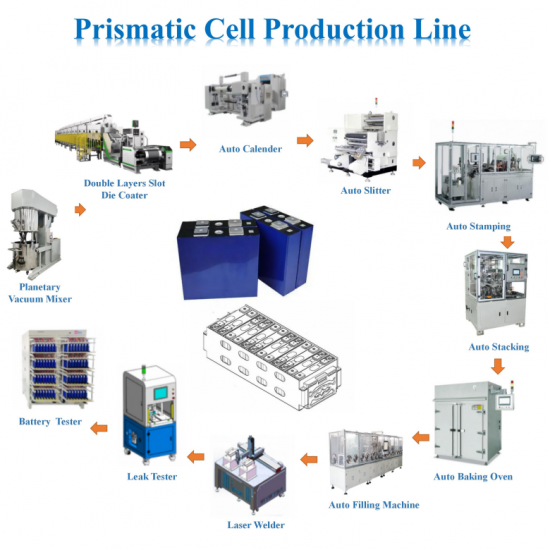Lith Corporation, founded in 1998 by a group of material science doctor from Tsinghua University, has now become the leading manufacturer of battery lab&production equipment. Lith Corporation have production factories in shenzhen and xiamen of China.This allows for the possibility of providing high quality and low-cost precision machines for lab&production equipment,including: roller press, film coater,mixer, high-temperature furnace, glove box,and complete set of equipment for research of rechargeable battery materials. Simple to operate, low cost and commitment to our customers is our priority.
What is an EV Car Battery Lab Plant?
An EV (Electric Vehicle) Car Battery Lab Plant is a dedicated research and development facility focused on the design, testing, and validation of battery cells, modules, packs, and associated technologies for electric vehicles.
Unlike fullscale battery assembly plants or pilot plants, a lab plant operates at a much smaller scale, often with benchtop or semiautomated equipment, and is primarily used for:
Battery chemistry research
Material formulation and electrode development
Cell design and performance evaluation
Thermal, electrical, and safety testing
Battery Management System (BMS) prototyping
Failure analysis and root cause investigation
These facilities are essential for universities, R&D institutions, startups, and automotive companies that want to explore new battery technologies before moving into prototype or pilot production stages.
Key Objectives of an EV Battery Lab Plant
1. Support Fundamental Research and Innovation
Explore novel chemistries like solidstate, sodiumion, silicon anodes, lithiumsulfur
Test alternative materials for cathodes, anodes, electrolytes, and separators
2. Enable Rapid Prototyping and Iteration
Build and test small batches of battery cells under controlled conditions
Quickly modify designs and evaluate performance impacts
3. Conduct InDepth Performance and Safety Testing
Measure energy density, power output, cycle life, and degradation behavior
Perform stress tests including overcharge, short circuit, thermal runaway
4. Validate Battery Components and Systems
Assess BMS algorithms, sensor accuracy, and communication protocols
Evaluate cooling system efficiency and packlevel thermal management
5. Provide Training and Skill Development
Handson experience for researchers, engineers, and students
Exposure to realworld battery testing and failure analysis
6. Serve as a PreDevelopment Hub for Larger Projects
Generate data and insights that inform future pilot lines or Gigafactory investments
Support technology transfer from academia to industry
Core Capabilities of an EV Battery Lab Plant
A wellequipped EV battery lab plant typically includes the following specialized areas and tools:
1. Battery Cell Fabrication Lab
This area supports the development and smallscale production of battery cells.
Key capabilities include:
Slurry preparation: Mixing active materials, binders, solvents
Electrode coating: Slotdie coating, doctorblade, spray coating
Drying and calendering: Removing solvents and adjusting electrode density
Slitting and stacking/winding: Cutting electrodes and assembling cell components
Cell assembly: Sealing pouch or coin cells in glovebox environments
Electrolyte filling: Under dry air or inert gas atmosphere
Formation & aging: First charge/discharge cycle and stabilization
2. Battery Testing and Characterization Lab
This lab focuses on performance evaluation and failure analysis.
Testing capabilities include:
Electrochemical testing: Cyclic voltammetry, EIS (electrochemical impedance spectroscopy)
Capacity testing: Charge/discharge cycles under various temperatures
Cycle life testing: Repeated charging/discharging to assess degradation
Rate capability testing: Highpower discharge/charge performance
Calendar aging testing: Longterm storage under different conditions
Safety testing: Overcharge, external short, nail penetration, crush tests
Thermal testing: Thermal conductivity, heat generation, cooling performance
3. Battery Management System (BMS) Development Lab
The BMS lab supports the design, simulation, and validation of intelligent battery control systems.
Key activities include:
Hardware design: PCB layout, component selection, signal conditioning
Firmware development: Charging algorithms, balancing strategies, diagnostics
Communication protocols: CAN, LIN, Ethernet, wireless connectivity
Functional safety validation: ISO 26262 compliance, fault detection
Simulation and modeling: Digital twins for BMS and battery behavior
Integration testing: With vehicle control systems and cloud platforms
4. Thermal Management and Simulation Lab
This area focuses on managing heat within battery systems.
Capabilities include:
Thermal interface material (TIM) testing
Cooling system design: Aircooled vs. liquidcooled systems
Thermal modeling and simulation: Finite Element Analysis (FEA), CFD
Temperature uniformity testing: Hot spot detection and mitigation
Phase change materials (PCM): Alternative thermal regulation methods
Fire suppression and thermal runaway propagation studies
5. Materials Science and Failure Analysis Lab
This lab supports deep understanding of battery materials and failure modes.
Tools and techniques include:
SEM (Scanning Electron Microscopy) – Analyze microstructure
XRD (Xray Diffraction) – Identify crystal structures
FTIR / Raman Spectroscopy – Analyze chemical composition
EDS (Energy Dispersive Spectroscopy) – Elemental mapping
XPS (Xray Photoelectron Spectroscopy) – Surface chemistry analysis
Crosssectioning and polishing – Prepare samples for inspection
Postmortem analysis – Investigate failed cells and degradation mechanisms
6. Clean Room and Dry Room Infrastructure
To support moisturesensitive operations such as:
Gloveboxes – For handling Limetal, solidstate batteries, etc.
Dry rooms – Humidity <1% RH for electrolyte filling and electrode handling
Air filtration systems – Maintain particulatefree environment
Explosionproof enclosures – For flammable solvent processes
Climatecontrolled storage – For sensitive raw materials and components
Prismatic Cell Equipments
7. Data Acquisition and Analytics Platform
Modern battery labs use digital tools to track and analyze experimental results.
Features include:
Test automation software – Control charge/discharge cycles
Data logging systems – Record voltage, current, temperature in real time
Cloudbased data storage – Enable collaboration and remote access
Machine learning tools – Predict degradation and optimize battery usage
Digital twins – Simulate battery behavior under different conditions
8. Sustainability and Safety Protocols
Even at a small scale, sustainability and safety are essential:
Battery recycling and material recovery – Recover metals like Li, Co, Ni
Waste treatment systems – Handle hazardous chemicals safely
Fire protection systems – Flameresistant cabinets, suppression agents
Emergency response plans – Fire drills, spill containment, PPE
Worker training programs – Safe handling of reactive materials
Types of EV Battery Lab Plants
Depending on ownership and purpose, these labs can be categorized as:
1. Academic and University Battery Labs
Operated by universities for teaching and fundamental research
Example: MIT Energy Initiative, Stanford Precourt Institute
Focus: Material science, electrochemistry, nextgen battery tech
2. National Research Laboratory Facilities
Governmentfunded centers for advanced battery R&D
Example: Argonne National Lab (USA), Fraunhofer ISE (Germany)
Focus: Technology development, standardization, national innovation
3. Corporate R&D Battery Labs
Owned by automotive OEMs or battery suppliers
Example: BMW Group Battery Lab, Toyota Advanced Battery R&D
Focus: Product development, supplier qualification, IP creation
4. Startup Incubation Battery Labs
Designed for earlystage battery tech companies
Located in innovation hubs or industrial parks
Offer shared infrastructure and mentorship
5. Collaborative IndustryAcademia Labs
Joint ventures between companies and universities
Example: CATL + Tsinghua University, Farasis + Honda
Aim: Accelerate commercialization of academic breakthroughs
Key Considerations When Building an EV Battery Lab Plant
When planning your battery lab, consider the following factors:
| Area | Consideration |
|||
| Location | Proximity to universities, R&D centers, and supply chain |
| Lab Size | Square footage, clean room requirements, ventilation |
| Battery Chemistry | NMC, LFP, solidstate, sodiumion, etc. |
| Facility Type | Benchtop, semiautomated, or modular automation |
| Environmental Compliance | Fire safety, emissions, waste handling |
| Equipment Selection | Cell making machines, testing rigs, analytical tools |
| Data Systems | MES integration, cloud storage, AI analytics |
| Workforce Development | Training for scientists, engineers, and technicians |
| Partnerships | Universities, OEMs, government grants, investors |
Benefits of an EV Battery Lab Plant
Enables cuttingedge research into nextgeneration battery technologies
Accelerates innovation through rapid experimentation and iteration
Reduces risk before investing in largescale manufacturing
Builds technical expertise and intellectual property internally
Supports education and workforce development
Attracts funding and strategic partnerships
Promotes sustainable battery development and circular economy
Leading Institutions and Companies Involved in EV Battery Lab Development
Here are some of the key players involved in designing and operating EV battery lab plants globally:
Academic & Research Institutions:
MIT Energy Initiative (USA) – Battery innovation and policy
Stanford University (USA) – Advanced materials and electrochemistry
Fraunhofer ISE (Germany) – Battery manufacturing and testing
Argonne National Laboratory (USA) – Cell chemistry and materials science
CEALiten (France) – Nextgen battery technologies
NREL (USA) – Sustainable battery development
Automotive OEMs:
BMW Group (Germany) – Internal battery R&D and testing
Toyota (Japan) – Solidstate battery research lab
Ford & SK On (USA/South Korea) – Collaborative battery innovation
Volkswagen Group (Germany) – Battery cell development center
Battery Startups:
Factorial (USA) – Solidstate battery research
QuantumScape (USA) – Lithiummetal battery prototypes
Blue Solutions (France) – Sodiumion and flexible battery R&D
StoreDot (Israel) – Fastcharging battery materials
Equipment and Automation Providers:
Neware, Bitrode, Arbin Instruments – Battery testing systems
Hanson Robotics, Gree EnergyTech – Modular battery line solutions
Koehler Instrument Company – Electrolyte and separator testing
Keysight Technologies – Data acquisition and measurement systems
Engineering and Lab Design Firms:
CRB, Jacobs, GHD, Stantec – Lab planning and construction
Exyte, Linde Engineering, Sweco – Clean room and dry room design
EHS consulting firms – Environmental and safety compliance
Need Help Designing or Optimizing Your EV Battery Lab Plant?
If you're looking to build, expand, or optimize your EV battery lab plant, I can help you with:
Master planning – Site layout, process flow, zoning
Lab design – Clean room placement, ventilation, safety zones
Equipment selection – Cell making tools, testing rigs, analyzers
Sustainability strategy – Waste reduction, green chemistry
Cost estimation and ROI analysis – CapEx, OpEx, breakeven modeling
Compliance and safety systems – Fire protection, permits, worker safety
Training and curriculum development – Student and engineer programs
All you need to do is provide the following information:
Battery chemistry and focus area (e.g., solidstate, fast charging, recyclability)
Target annual testing capacity (e.g., 100–1,000 cells/month)
Lab location and available infrastructure
Level of automation and digitalization desired
Current team expertise and strategic goals




 Online service
Online service
